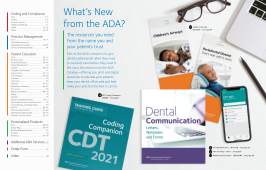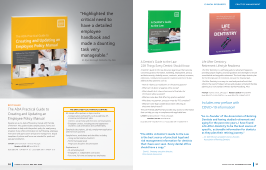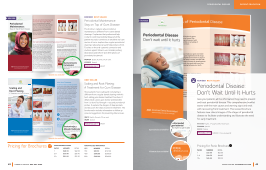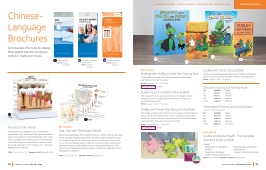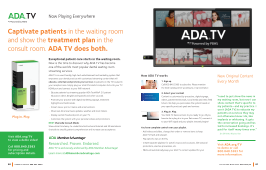The ADA Practical Guide to Substance Use Disorders and Safe Prescribing With the opioid abuse crisis, it’s more important than ever to understand substance use disorders (SUD) and how to prescribe medication safely. This practical guide is vital for dentists and staff as they navigate: • Detecting and deterring substance use disorders and drug diversion in the dental office (drug-seeking patients) • Prescribing complexities • Treating patient with SUD and complex analgesic and sedation (pain/sedation management) needs and the best use of sedation anxiety medication • Interviewing and counseling options for SUD • Federal drug regulations Commonly used illicit, prescription and over-the-counter drugs, as well as alcohol and tobacco, are also covered. Earn 5 hours CE credit.* *CE tests are subject to a $20 grading fee per test. P035 Paperback book, 220 pages | Members $72.95 Retail $102.95 Book ISBN: 978-1-118-88601-4 Help prevent opioid abuse in your practice with this ADA guide. Dental Drug Handbook and Medical Conditions Kit Kit includes: • ADA Dental Drug Handbook • Patients with Medical Conditions K027 Kit, 2 Books Members $104.95 Retail $152.95 ADA Dental Drug Handbook: A Quick Reference This concise guide contains the latest information from dental pharmacology’s leading experts. It covers the drugs most commonly used in the dental practice, with information about dosage, possible interactions, potential complications and more. This guide, designed to fit in a lab-coat pocket, makes it easy to use whether you’re in the operatory or catching up in between patients. J059BT Spiral bound book + e-book, 164 pages, 5.5” x 8.5” | Members $39.95 Retail $59.95 Book ISBN: 968-1-68447-046-4 | e-book ISBN: 978-1-68447-052-5 158 Table 2. Drug-Drug Interactions Most common prescribed drugs in dental medicine Most Common Prescribed Drugs in 2017 Alprazolam Amlodipine Amoxicillin Atorvastatin Azithromycin Furosemide Gabapentin Hydrochloro- thiazide Hydrocodone/ APAP Ibuprofen Analgesics Acetaminophen X Aspirin X X X XX Celecoxib X X X X Ibuprofen X X Naproxen X X XX Codeine X X Hydrocodone XX XX Hydromorphone X X Oxycodone X X Tramadol X XX Anesthetics Articaine Bupivacaine Lidocaine X Mepivacaine Prilocaine Phentolamine X X Antibiotics Amoxicillin X X Azithromycin X X Clindamycin Doxycycline XX Erythromycin XX X X XX X Metronidazole XX X X X Penicillin VK X X X Antifungals Clotrimazole X X Fluconazole X X X X X Nystatin Voriconazole X X X XBOX XX X Antivirals Acyclovir X X X ValAcyclovir Anxiolytics Diazepam X XX Triazolam X XX Corticosteroids Dexamethasone X X X X X XX X Legend: X - Monitor XX - Avoid XXX - Contraindicated 22 Chapter 2 l Antibiotics Clindamycin – A Lincosamide Tablet: 150 mg, 300 mg • Liquid: 75 mg/5 mL ORAL CONDITIONS • Acute oral infection • Prophylaxis SAMPLE PRESCRIPTION • Take 1 tablet (150 mg) 4 times per day for 7-10 days (28-40 tablets) • For prophylaxis, take 4 tablets (4x 150 mg) 1 hour before procedure (4 tablets) BLACK WARNING – C. difficile-assoc. diarrhea (CDAD) has been reported and may range in severity from mild diarrhea to fatal colitis. Caution is recommended when prescribing this drug to patients with a history of CDAD or gastro-intestinal disorders. CONTRAINDICATIONS • Hypersensitivity to clindamycin, lincomycin CAUTIONS • Patients with hepatic or renal impairment MAJOR & SEVERE DRUG INTERACTIONS • This drug ↓ the effect of: - Antibiotics such as erythromycin - Live vaccines such as BCG, cholera, typhoid • This drug ↑ the concentration and respiratory depression of Neuromuscular blocking agents such as succinylcholine, onabotulinumtoxinA, vecuronium ADVERSE DRUG REACTIONS Common reactions: • Rash, urticaria, pruritus • Diarrhea, nausea, vomiting • Hypotension, jaundice • Metallic taste Less common reactions: • Anaphylaxis, Stevens-Johnson syndrome, toxic epidermal necrolysis • C. difficile-assoc. diarrhea, fungal overgrowth • Renal impairment, vaginitis PATIENT CONSIDERATIONS • Pregnancy Category B • Lactation: excreted in breast milk compatible with breastfeeding • Monitor patients with renal impairment • Monitor patients with hepatic impairment • May take with food DRUG CONSIDERATIONS • Peak serum time: 1-3 hr • Bioavailability: 90% • Half-life: 2-3 hr • Excretion: urine (10%), feces (4%) INCLUDES • Drugs used in dentistry, such as analgesics, antibiotics, antifungals, antivirals, anxiolytics, fluorides, local anesthetics and corticosteroids • Smoking cessation, salivary management and oral lesion treatments • OTC products with the ADA Seal of Acceptance • ADA Guidelines on procedures such as general anesthesia, antibiotic prophylaxis and medication- related osteonecrosis of the jaw • Drug management for: - pediatrics - emergency situations - special care patients such as pregnant patients and the elderly Trust the ADA Dental Drug Handbook for contraindications and safe prescribing practices. 20 ORDER BY PHONE: 800.947.4746 CLINICAL RESOURCES ORDER ONLINE: ADACATALOG.ORG 21 PRACTICE MANAGEMENT
Purchased by , From: ADA Ebooks (ebooks.ada.org)


